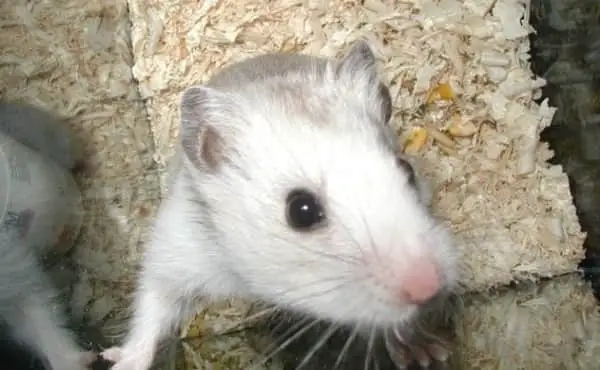When hamsters are not sleeping or eating, they are very often running. Hamsters run in their wheels, around their cages, and across their owners’ hands and laps. Although some are calmer than others, a lazy hamster is something you will rarely see.
So, why does my hamster never stay still? First, they are very high-energy animals who would do a lot of running in their natural environment. They are also skittish, curious, and sometimes uncomfortable with being held. A hamster that runs itself to exhaustion may have a neurological or mental disorder.
In this article, we’ll explore the reasons behind a hamster’s naturally high energy level and look at some of the best ways you can accommodate this energy to keep your hamster mentally and physically healthy. We’ll also note warning signs of unnaturally fearful, restless, or manic behavior and what you should do if your hamster evidences them.
Naturally High Energy
Hamsters have an amazing amount of energy. In the wild, they spend much of their waking time covering large distances and searching for food. A dwarf hamster in the wild usually has a territory of about 1.3 miles. That’s a lot of space for such a tiny animal to crisscross regularly! And a Syrian hamster’s territory may be twice as large.
How it Translates in Captivity
A domesticated hamster still has all that energy to burn, but its territory is much, much smaller. Your hamster instead needs to use up its energy running in a wheel, scurrying about its cage, and getting some out-of-the-cage playtime with you. On average, a hamster may run up to 5.5 miles in its wheel every night.
Most hamsters will also take breaks from the wheel to traverse their entire cages, including any tunnels and climbing toys several times during their waking hours. They may take a few minutes to eat, drink, hoard some food, and dig in their bedding. This is all natural behavior that would simply be spread over a much larger area in the wild.
Accommodating Your Hamster’s High Energy
It’s very important that your hamster has these alternative options for burning all of its energy. Without them, a hamster can become very stressed, develop abnormal behaviors and psychological disorders, or even become ill and die. The following accommodations are essential for keeping your high-energy hamster healthy and happy.
A hamster wheel—Make sure it’s big enough that your hamster can comfortably run in it for hours without stressing its back. It’s also best to look for one that doesn’t squeak or rattle as your hamster will most often be using it when you’re trying to sleep. Choose a sturdy model with a solid running surface—wire wheels or wheels with a grid-like running surface can be hard on your hamster’s feet and also put it in danger of getting a toe or tail stuck.
The biggest cage possible—Hamsters need as much open space as you can offer to keep them from becoming claustrophobic and stressed. Few commercially-made cages are large enough, so you may wish to connect several cages with tunnels or try a large tank or bin cage, especially for Syrian hamsters. The cage should have room for several toys and hideaways without being crowded.
Tunnels, hideaways, and toys to climb and chew—A hamster with only a wheel and some space still may become bored and stressed. Although we have limited information about how to tell if a hamster is happy, one study showed that hamsters with lots of toys and fun items to explore were more curious and interested in their surroundings, which suggests that they were happier. Lots of enrichment can also keep your hamster from developing cage rage, which we’ll discuss later.
Playtime—Get your hamster out of its cage frequently for short play sessions. If you can safely do so, let it run around on the floor or your bed and explore new areas. You may also wish to let it explore your house in a hamster ball. Just make sure the ball is large enough for your hammy and always supervise its exploration so that it won’t end up tumbling down the stairs or getting kicked.
Instinct to Evade
Another reason hamsters never seem to stay still is that they have a very strong instinct to evade. In the wild, they are a prey animal, so they always need to be prepared to run, hide, or dodge if a predator comes after them. If you’ve ever tried to catch a loose hamster who wasn’t ready to return to its cage, you know they are very good at this!
How This Affects Your Pet
Even though it may be in no danger in your home, your hamster doesn’t know this. It may be easily startled by quick movements or loud noises and will almost definitely become skittish if you try to catch or grab it.
Hamsters are very unlikely to sit quietly in your hand or lap. Some hamsters never learn to like being held, and it’s hard to blame them when their instincts are screaming at them to stay on the move.
Dealing With a Squirmy Hammy
Learn to cup your hamster gently and securely in your hands so it won’t squirm itself right onto the floor. If it climbs out of one hand, you can have the other ready for it, putting one hand in front of the other kind of like an escalator.
It’s best to sit close to the floor when holding your hamster or letting it play in your lap, as hamsters have poor eyesight and sometimes do walk off the edge of things.
Negative Energy and Neurological Disorders
With all that energy to burn, it’s not surprising that things can turn ugly if a hamster doesn’t have enough positive outlets for its liveliness. Pent-up energy and curiosity with no place to go can morph into grouchiness, repetitive or compulsive behavior, and cage rage.
Boredom and Restlessness
What about a hamster is beginning to pace, dashing back and forth along the same route in its cage, or constantly tries to escape its cage by scratching or chewing at the bars?
This obsessive-compulsive activity, known as stereotypic behavior, is your hamster’s way of exhibiting stress brought on by boredom, confinement, or overcrowding. Unless you are able to address the root cause of this behavior, it will only get worse.
Take another look at your hamster’s habitat and routine. Does it have enough space? Is its space clean and interesting? Is it being stressed by another pet or something in its surroundings? Does it have a wheel that it likes using, at least one hideaway, and toys to climb and chew? Do you get it out regularly?
Cage Rage
The disorder known as “cage rage” most often develops in hamsters whose cages are too small or too crowded. It manifests as extreme restlessness. A hamster may run loops around its cage over and over.
It may chew the bars endlessly, even breaking its teeth in its attempts to escape. A hamster with cage rage may become aggressive and sleep in odd patterns or hardly seem to sleep at all.
Again, all of this will only grow worse if the root cause is not addressed as quickly as possible. Eventually it may be irreversible and lead to death. You can avoid cage rage by giving your hamster the largest habitat possible and enriching its life from day one.
Stargazing and Spinning
Finally, a hamster may never stay still because it has a neurological disorder known as “stargazing” or “spinning.” This disorder is often the result of genetics and is most common in Winter White dwarf hamsters. It’s also exacerbated by stress.
A hamster with the disorder may stand on its hind legs over and over again, looking upward or even flipping over backward. It may also dash around in a repetitive loop or even appear to spin in place.
These behaviors look abnormal because they are. A hamster with the stargazing disorder can’t control what it’s doing. If you suspect your hamster may have this neurological disorder, check with your vet and try to avoid stressing it as much as possible.
Conclusion
Usually, there is nothing wrong with a hamster that seems to be constantly on the move. As long as a hammy is sleeping and eating regularly and appears to be healthy and unstressed, all of the activity is just a result of natural inclination and instincts.
Your hamster is built to run and climb and explore. However, it is important that you do your best to provide safe, interesting outlets for this energy to avoid the stress and boredom that can lead to unhappy, unhealthy behaviors.
Some hamsters are more hyper than others, and this can lead to some frustration if you were hoping to spend more time holding and cuddling your pet. Learn instead to enjoy finding ways to enrich its life and foster its curiosity and watching it run and play.




